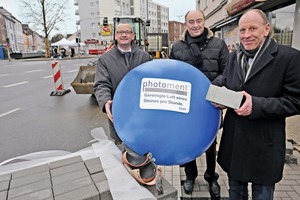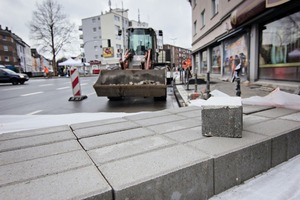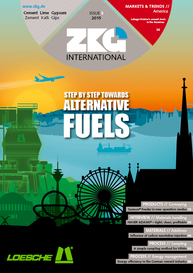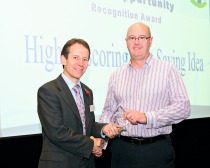Paving stones clean city air
An innovative construction material which STEAG Power Minerals has developed and optimized over a number of years could point the way to the future for local authorities: Paving stones that improve air in urban areas. They are made of regular cement, sand, gravel and water plus a concrete additive called Photoment® (see box). A test area laid out in Bottrop’s inner city is to prove that the effect is not confined to the laboratory. At the ground breaking ceremony at busy Peterstraße, Mayor Bernd Tischler, Burkhard Drescher, managing director of the InnovationCity management company, and Andreas Hugot, managing director of STEAG Power Minerals, appeared confident (Fig. 1).
“We are extremely pleased to have this opportunity to demonstrate Photoment® in practice here in Innovation City,” said Andreas Hugot. From the point of view of the city, Mayor Tischler summed up the advantages of the test project: “The InnovationCity RuhrModelCity Bottrop project as a whole is aiming at a climatically sound transformation of the urban environment while retaining its industrial character. We regard this as a further exciting and innovative project.”
The new paving stones (Fig. 2) contain the additive Photoment® with its unusual properties. Together with partners, STEAG Power Minerals developed the concrete additive, which can break down the harmful nitrogen oxides from the traffic in busy inner cities. It is photocatalytically active. That means that under the influence of (sun-)light, concrete slabs with Photoment® can on the one hand decompose the hazardous nitrogen oxides from the air, and on the other hand reduce soiling and organic growths on the surfaces. Photoment® can be added to any conventional paving stone during manufacture. With the innovative slabs, the air quality and the quality of life can be significantly improved, particularly in inner cities with traffic pollution.
The test area of around 750 m2 at the crossroads of Peterstraße and Kapitän-Lehmann-Straße is to be paved by mid-February. Mayor Bernd Tischler comments: “According to calculations by the Technical University of Berlin, one of these slabs cleans more than a cubic meter of air each hour. Our small test area in Bottrop is therefore in the ideal case able to clean more than the volume of our Tetrahedron landmark structure photocatalytically in one hour. That’s great performance.”
//www.steag.com" target="_blank" >www.steag.com:www.steag.com




